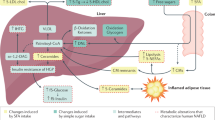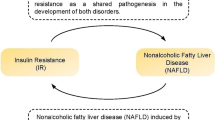Abstract
Background
Although the role of a diet rich in fructose and saccharose in development of nonalcoholic fatty liver disease (NAFLD) is well known, the effects of a low free sugar diet in the management of the disease have not yet been investigated in adult patients with NAFLD. We aimed, therefore, to analyze the effects of a low-free sugar diet on NAFLD main features.
Methods
Participants with FibroScan-proven NAFLD were randomized to a 12-week dietary intervention (low free sugar diet or usual diet). The primary outcome was change in hepatic steatosis measurement between baseline and 12 weeks. The secondary outcomes included changes in anthropometric measurements, lipid profile, glycemic indices, liver enzymes, and inflammatory factors.
Results
Forty-three subjects completed the 12-week intervention. Low free sugar diet compared with the usual diet significantly decreased the concentrations of ALT (43.00 ± 27.54 to 27.95 ± 20.77 U/L), TG (172.86 ± 83.04 to 144.19 ± 65.55), TC (155.54 ± 37.55 to 139.86 ± 33.63 mg/dL), FBS (103.95 ± 15.42 to 91.00 ± 14.36 mg/dL), insulin (14.37 ± 5.79 to 8.92 ± 5.43 mU/L), HOMA-IR (3.81 ± 1.80 to 2.06 ± 1.29), hs-CRP (3.80 ± 1.09 to 2.88 ± 0.52 mg/L), TNF-α (4.60 ± 1.54 to 3.41 ± 0.69 pg/mL), NF-kb (3.89 ± 1.34 to 3.35 ± 1.33), as well as resulted in reduced fibrosis score and steatosis score, with increased QUICKI (P < 0.05). The differences in AST, GGT, HDL-C and LDL-C were not significant (P > 0.05).
Conclusion
Low free sugar diet in overweight/obese NAFLD patients may reduce hepatic steatosis and fibrosis while improving glycemic indices, decreasing the concentrations of biomarkers of inflammation, TG, and TC levels.
This is a preview of subscription content, access via your institution
Access options
Subscribe to this journal
Receive 12 print issues and online access
$259.00 per year
only $21.58 per issue
Buy this article
- Purchase on Springer Link
- Instant access to full article PDF
Prices may be subject to local taxes which are calculated during checkout


Similar content being viewed by others
References
Arab JP, Candia R, Zapata R, Muñoz C, Arancibia JP, Poniachik J, et al. Management of nonalcoholic fatty liver disease: an evidence-based clinical practice review. World J Gastroenterol. 2014;20:12182.
Ahmed IA. Major dietary interventions for the management of liver disease. In: Dietary interventions in liver disease. Elsevier; 2019. 205–12.
Starley BQ, Calcagno CJ, Harrison SA. Nonalcoholic fatty liver disease and hepatocellular carcinoma: a weighty connection. Hepatology. 2010;51:1820–32.
Adams L, Angulo P. Recent concepts in non-alcoholic fatty liver disease. Diabet Med. 2005;22:1129–33.
Abdelmalek MF, Diehl AM. Nonalcoholic fatty liver disease and nonalcoholic steatohepatitis. Harrison’s Princ Intern Med. 2018;2:2054–7.
Oh M, Winn J, Poordad F. diagnosis and treatment of non‐alcoholic fatty liver disease. Alimentary Pharmacol Therapeutics. 2008;28:503–22.
Koot BG, van der Baan-Slootweg OH, Tamminga-Smeulders CL, Rijcken THP, Korevaar JC, van Aalderen WM, et al. Lifestyle intervention for non-alcoholic fatty liver disease: prospective cohort study of its efficacy and factors related to improvement. Arch Dis Child. 2011;96:669–74.
Chalasani N, Younossi Z, Lavine JE, Diehl AM, Brunt EM, Cusi K, et al. The diagnosis and management of non-alcoholic fatty liver disease: Practice Guideline by the American Association for the Study of Liver Diseases, American College of Gastroenterology, and the American Gastroenterological Association. Hepatology. 2012;55:2005–23.
Lee S, Bacha F, Hannon T, Kuk JL, Boesch C, Arslanian S. Effects of aerobic versus resistance exercise without caloric restriction on abdominal fat, intrahepatic lipid, and insulin sensitivity in obese adolescent boys: a randomized, controlled trial. Diabetes. 2012;61:2787–95.
Pozzato C, Verduci E, Scaglioni S, Radaelli G, Salvioni M, Rovere A, et al. Liver fat change in obese children after a 1-year nutrition-behavior intervention. J Pediatr Gastroenterol Nutr. 2010;51:331–5.
Vilar-Gomez E, Martinez-Perez Y, Calzadilla-Bertot L, Torres-Gonzalez A, Gra-Oramas B, Gonzalez-Fabian L, et al. Weight loss through lifestyle modification significantly reduces features of nonalcoholic steatohepatitis. Gastroenterology. 2015;149:367–78.e5.
Finelli C, Tarantino G. Is there any consensus as to what diet or lifestyle approach is the right one for NAFLD patients. J Gastrointestin Liver Dis. 2012;21:293–302.
EAftSoT Liver. Diabetes EAftSo. EASL-EASD-EASO Clinical Practice Guidelines for the management of non-alcoholic fatty liver disease. Obes Facts. 2016;9:65–90.
Softic S, Cohen DE, Kahn CR. Role of dietary fructose and hepatic de novo lipogenesis in fatty liver disease. Digestive Dis Sci. 2016;61:1282–93.
Girard J, Perdereau D, Foufelle F, Prip‐Buus C, Ferré P. Regulation of lipogenic enzyme gene expression by nutrients and hormones. FASEB J. 1994;8:36–42.
Vos MB, Lavine JE. Dietary fructose in nonalcoholic fatty liver disease. Hepatology. 2013;57:2525–31.
Garg A, Bantle JP, Henry RR, Coulston AM, Griver KA, Raatz SK, et al. Effects of varying carbohydrate content of diet in patients with non—insulin-dependent diabetes mellitus. JAMA. 1994;271:1421–8.
McLaughlin T, Abbasi F, Lamendola C, Yeni-Komshian H, Reaven G. Carbohydrate-induced hypertriglyceridemia: an insight into the link between plasma insulin and triglyceride concentrations. J Clin Endocrinol Metab. 2000;85:3085–8.
Hudgins LC, Hellerstein M, Seidman C, Neese R, Diakun J, Hirsch J. Human fatty acid synthesis is stimulated by a eucaloric low fat, high carbohydrate diet. J Clin Investig. 1996;97:2081–91.
Swan GE, Powell NA, Knowles BL, Bush MT, Levy LB. A definition of free sugars for the UK. Public health Nutr. 2018;21:1636–8.
Kargulewicz A, Stankowiak-Kulpa H, Grzymisławski M. Dietary recommendations for patients with nonalcoholic fatty liver disease. Prz Gastroenterologiczny. 2014;9:18.
WHO. Guideline: Sugars intake for adults and children. Geneva: World Health Organization; 2015.
Lam B, Younossi ZM. Treatment options for nonalcoholic fatty liver disease. Therapeutic Adv Gastroenterol. 2010;3:121–37.
Santos HO, Macedo RC. Impact of intermittent fasting on the lipid profile: assessment associated with diet and weight loss. Clin Nutr ESPEN. 2018;24:14–21.
Meng H, Zhu L, Kord-Varkaneh H, Santos HO, Tinsley GM, Fu P. Effects of intermittent fasting and energy-restricted diets on lipid profile: a systematic review and meta-analysis. Nutrition. 2020;77:110801.
Varkaneh HK, Tinsley GM, Santos HO, Zand H, Nazary A, Fatahi S, et al. The influence of fasting and energy-restricted diets on leptin and adiponectin levels in humans: a systematic review and meta-analysis. Clin Nutr. 2020; 1811–1821.
Schwimmer JB, Ugalde-Nicalo P, Welsh JA, Cordero M, Harlow KE, Alazraki A, et al. Effect of a low free sugar diet vs usual diet on nonalcoholic fatty liver disease in adolescent boys: a randomized clinical trial. JAMA. 2019;321:256–65.
Carrero JJ, Andersson Franko M, Obergfell A, Gabrielsen A, Jernberg T. hsCRP level and the risk of death or recurrent cardiovascular events in patients with myocardial infarction: a healthcare-based study. J Am Heart Assoc. 2019;8:e012638.
Ameer F, Scandiuzzi L, Hasnain S, Kalbacher H, Zaidi N. De novo lipogenesis in health and disease. Metabolism. 2014;63:895–902.
Jensen T, Abdelmalek MF, Sullivan S, Nadeau KJ, Green M, Roncal C, et al. Fructose and sugar: a major mediator of non-alcoholic fatty liver disease. J Hepatol. 2018;68:1063–75.
Bandsma RH, Prinsen BH, de Sain-van der Velden M, Rake J-P, Boer T, Smit GPA, et al. Increased de novo lipogenesis and delayed conversion of large VLDL into intermediate density lipoprotein particles contribute to hyperlipidemia in glycogen storage disease type 1a. Pediatr Res. 2008;63:702–7.
Aeberli I, Zimmermann MB, Molinari L, Lehmann R, Spinas GA, Berneis K. Fructose intake is a predictor of LDL particle size in overweight schoolchildren. Am J Clin Nutr. 2007;86:1174–8.
Santos HO, Earnest CP, Tinsley GM, Izidoro LF, Macedo RC. Small dense low-density lipoprotein-cholesterol (sdLDL-C): analysis, effects on cardiovascular endpoints and dietary strategies. Prog cardiovascular Dis. 2020;63:503–9.
Fattore E, Botta F, Agostoni C, Bosetti C. Effects of free sugars on blood pressure and lipids: a systematic review and meta-analysis of nutritional isoenergetic intervention trials. Am J Clin Nutr. 2017;105:42–56.
Walker HK, Hall WD, Hurst JW, editors. Clinical Methods: The History, Physical, and Laboratory Examinations. 3rd ed. Boston: Butterworths; 1990. PMID: 21250045.
Zhao S, Jang C, Liu J, Uehara K, Gilbert M, Izzo L, et al. Dietary fructose feeds hepatic lipogenesis via microbiota-derived acetate. Nature. 2020;579:586–91.
FUKUDA H, IRITANI N, TANAKA T. Effects of high-fructose diet on lipogenic enzymes and their substrate and effector levels in diabetic rats. J nutritional Sci Vitaminol. 1983;29:691–9.
Hotamisligil GS, Arner P, Caro JF, Atkinson RL, Spiegelman BM. Increased adipose tissue expression of tumor necrosis factor-alpha in human obesity and insulin resistance. J Clin Investig. 1995;95:2409–15.
Sewter C, Digby J, Blows F, Prins J, O’Rahilly S. Regulation of tumour necrosis factor-alpha release from human adipose tissue in vitro. J Endocrinol. 1999;163:33–8.
Kerner A, Avizohar O, Sella R, Bartha P, Zinder O, Markiewicz W, et al. Association between elevated liver enzymes and C-reactive protein: possible hepatic contribution to systemic inflammation in the metabolic syndrome. Arteriosclerosis Thrombosis Vasc Biol. 2005;25:193–7.
Ajmal MR, Yaccha M, Malik MA, Rabbani M, Ahmad I, Isalm N, et al. Prevalence of nonalcoholic fatty liver disease (NAFLD) in patients of cardiovascular diseases and its association with hs-CRP and TNF-α. Indian Heart J. 2014;66:574–9.
York LW, Puthalapattu S, Wu GY. Nonalcoholic fatty liver disease and low-carbohydrate diets. Annu Rev Nutr. 2009;29:365–79.
Toshimitsu K, Matsuura B, Ohkubo I, Niiya T, Furukawa S, Hiasa Y, et al. Dietary habits and nutrient intake in non-alcoholic steatohepatitis. Nutrition. 2007;23:46–52.
Haufe S, Engeli S, Kast P, Böhnke J, Utz W, Haas V, et al. Randomized comparison of reduced fat and reduced carbohydrate hypocaloric diets on intrahepatic fat in overweight and obese human subjects. Hepatology. 2011;53:1504–14.
Macedo RC, Santos HO, Tinsley GM, Reischak-Oliveira A. Low-carbohydrate diets: effects on metabolism and exercise–a comprehensive literature review. Clin Nutr ESPEN. 2020;26:17–26.
Santos HO, Price JC, Bueno AA. Beyond fish oil supplementation: the effects of alternative plant sources of omega-3 polyunsaturated fatty acids upon lipid indexes and cardiometabolic biomarkers—an overview. Nutrients. 2020;12:3159.
Scorletti E, Byrne CD. Omega-3 fatty acids, hepatic lipid metabolism, and nonalcoholic fatty liver disease. Annu Rev Nutr. 2013;33:231–48.
Musa-Veloso K, Venditti C, Lee HY, Darch M, Floyd S, West S, et al. Systematic review and meta-analysis of controlled intervention studies on the effectiveness of long-chain omega-3 fatty acids in patients with nonalcoholic fatty liver disease. Nutr Rev. 2018;76:581–602.
Acknowledgements
We thank all participants in this study without whom the study was impossible. The study was financially supported by Shahid Beheshti University of Medical Sciences.
Author information
Authors and Affiliations
Contributions
The authors’ responsibilities were as follows—BKH and AH: conceptualized and designed the study and wrote the manuscript; BKH and HK: analyzed the data; BKH, ZY, SMA, BH, AS, and AH: collected the data; HOS and AH: interpreted the data, and provided professional comments; AH: critically revised the manuscript for intellectual content and data accuracy; AH had responsibility for the final content; and all authors read and approved the final manuscript.
Corresponding author
Ethics declarations
Competing interests
The authors declare no competing interests.
Additional information
Publisher’s note Springer Nature remains neutral with regard to jurisdictional claims in published maps and institutional affiliations.
Rights and permissions
About this article
Cite this article
Khodami, B., Hatami, B., Yari, Z. et al. Effects of a low free sugar diet on the management of nonalcoholic fatty liver disease: a randomized clinical trial. Eur J Clin Nutr 76, 987–994 (2022). https://doi.org/10.1038/s41430-022-01081-x
Received:
Revised:
Accepted:
Published:
Issue Date:
DOI: https://doi.org/10.1038/s41430-022-01081-x
This article is cited by
-
Different dietary carbohydrate component intakes and long-term outcomes in patients with NAFLD: results of longitudinal analysis from the UK Biobank
Nutrition Journal (2023)
-
Reply to: ‘Guidelines on ‘added’ sugars are unscientific and unnecessary’
Nature Reviews Cardiology (2022)
-
Reply to: ‘Evidence does not support the reduction of added sugar intake from all food sources’
Nature Reviews Cardiology (2022)



